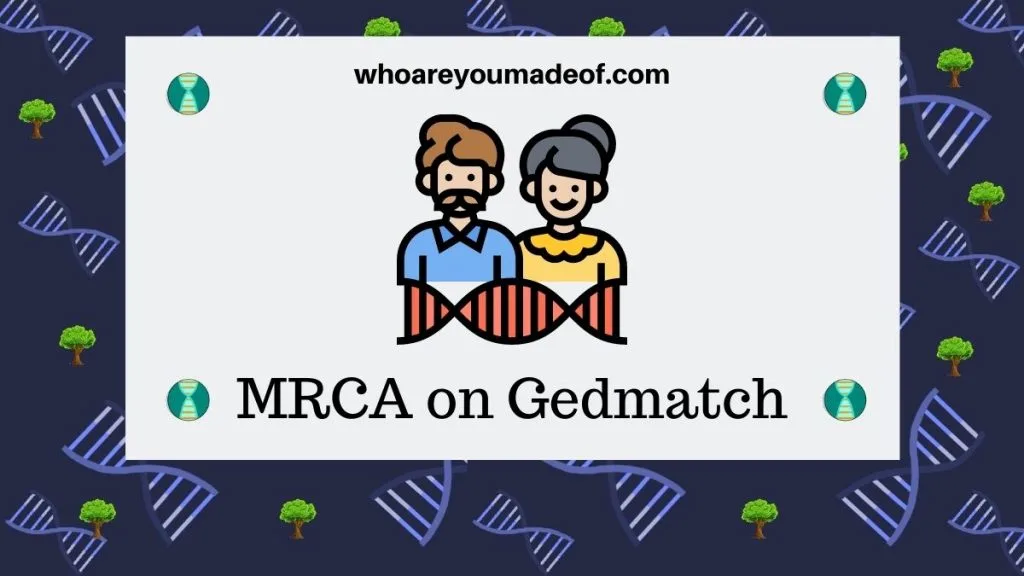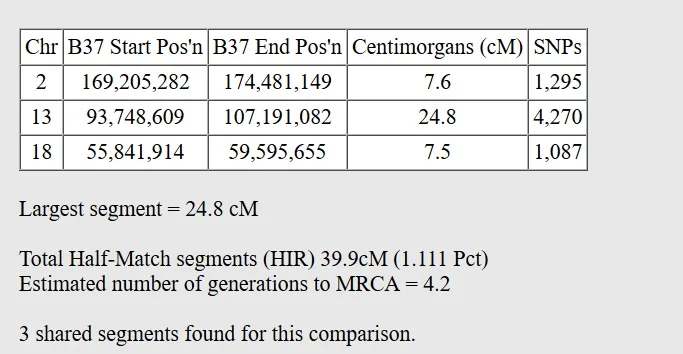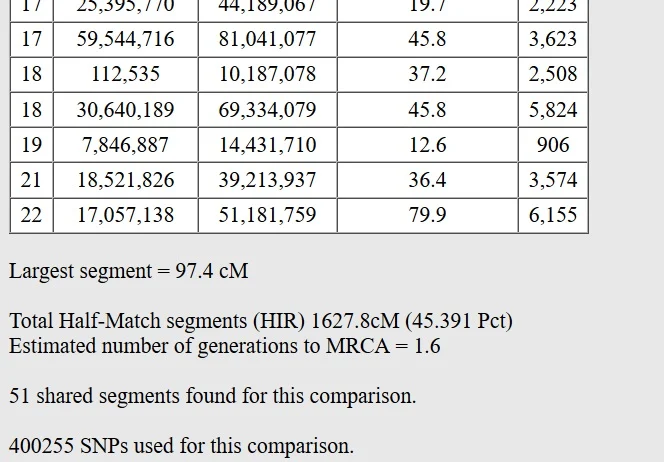Do you want to know what MRCA means on Gedmatch? In this post, learn exactly what MRCA means, as well as how to use this information to understand your connection to your DNA matches.

The term MRCA is most often found on the Gedmatch Autosomal One-to-One Comparison Tool. This is a very useful tool that allows us to compare our DNA with the DNA uploaded by other Gedmatch users.
In order to use the comparison tool, you must have uploaded your DNA to Gedmatch, as well as have the kit number of the person whose DNA you would like to compare to your own.
The One-to-One tool essentially serves as a chromosome browser, letting us view the exact size and location of shared DNA segments between two Gedmatch users. On the results page for this tool, we see the words "Estimated number of generations to MRCA".
What does MRCA mean on Gedmatch?
MRCA stands for "most recent common ancestor". The most recent common ancestor is the most recent ancestor from whom both you and your DNA match are descended.
We use the term MRCA because it is possible to be related to someone in more than one way. For example, you might be third cousins on one line of your tree and ninth cousins on another.
Most of the time, we are most interested in our most recent connection - or common ancestor - to our relatives, including our DNA matches. In addition, we share all ancestors with our relatives that are ancestors of the most recent common ancestor.
Thus, the use of the expression most recent common ancestor, or MRCA, for short.
We usually see MRCA on Gedmatch included along with an estimated number of generations.
In the image below, the Gedmatch tool estimates that we would have to look about 4.2 generations back in the family trees of these two DNA matches in order to find their most recent common ancestor (MRCA).

The estimated number of generations to MRCA is the Gedmatch software's best estimate to how far back in you and your DNA match's family tree you would need to look in order to find your most recent common ancestor. This is only an estimate, however.
Hopefully, both of these people have built family trees! It makes it much easier to determine how DNA matches are related.
Towards the end of this article, you will find more information about how to understand this estimate.
How to understand estimated number of generations to MRCA on Gedmatch?
The estimated number of generations to MRCA is simply an educated guess made by the Gedmatch algorithm based on the total amount of shared DNA and the number of DNA segments shared. The software is able to make this estimation because there is a range of shared DNA seen between relatives of every distance.
Let's take two DNA matches who share 1627.8 centimorgans with each other. I happen to know that they are half-siblings.

We see that the tool results estimate that there is 1.6 generations between these two relatives and their common ancestor. Going back one generation to the MRCA common ancestor takes us to a share parent.
If we go back two generations, we find a shared grandparent. Obviously, we know that half-siblings share one parent.
We also understand that we can't really go .6 of a generation in our family tree. The midway between the estimated generations simply mean that the tool estimates that the common ancestor is more recent than 2.0 generations.
Is the estimated generations to MRCA always right?
The estimated number of generations is only an estimate. We don't really say whether the estimate is correct, since we understand that the estimate is simply meant as a general guideline.
As I mentioned earlier, it is also possible to be related to someone in more than one way. Sometimes, this means that we inherited DNA from multiple shared common ancestors on different lines of our family tree.
When this occurs, we might share a little bit more DNA with our relative. This has the effect of skewing the results of relationship estimates, making us look like we are more closely related to our DNA matches than we really are.
This is very common when there is a lot of endogamy on our DNA match list.
We can also see the estimated generations skewed the other direction when there is a "half" relationship. This is because people who share one ancestor in common (instead of two), such as half-first cousins who share one grandparent, will share about half of the amount of DNA typically shared.
Gedmatch MRCA chart
Below you will find a chart with the estimated generation and the relationship of that MRCA to you:
- Estimated number of generations to MRCA = 1.0 > your parents
- Estimated number of generations to MRCA = 2.0 > your grandparent
- Estimated number of generations to MRCA = 3.0 > your great-grandparent
- Estimated number of generations to MRCA = 4.0 > your great-great grandparent
- Estimated number of generations to MRCA = 5.0 > your great-great-great grandparent
The estimated number of generations to MRCA will be more accurate for closer relationships. Even so, there is overlap in shared DNA between almost every relationship.
In other words, it is impossible to estimate our relationship to other people based only on the amount of shared DNA with 100% accuracy. There are very few exceptions to this rule.
Even so, we do find the estimated generations to MRCA number very useful. This information can give us an idea as to how far back we should look in our tree to find the person from whom our DNA match is also descended.
Once we know this information, we can do a little more work on our tree to see if we can make the identification. It may also occasionally be necessary to do a little work on our DNA match's tree - this is a good way to find the MRCA when there is a disparity in the size of your tree compared to your DNA match.
Conclusion
I sincerely hope that this post helped you understand more about what MRCA really means, what it stands for on the Gedmatch site, as well as how to use this information in your research.
If you have any questions about something that you read on this post, I would love to hear from you in the discussion below.
Thanks for stopping by today!


Mike
Tuesday 21st of May 2024
Hi there. I found this article very useful as I’ve been trying to get to grips with my Gedmatch matches and am about to experiment with “triangulation”. Some of my Ancestors came from a region where 2nd cousins marrying was common so the comments on “endogamy” was extremely helpful. Could I just clarify one thing which often confuses me? When Gedmatch tells me a MRCA is 5 generations back does than mean I count back from myself being generation 1 parent is 2 grandparent is 3 etc? Or is it parent is 1 back grandparent 2 back etc? Would be most grateful for your comments. Regards Mike.
Karen
Sunday 29th of May 2022
Trying to see what generations 1.5 means. We match (HIR) 1797cM (50.105 Pct
Mercedes
Sunday 5th of June 2022
Hi Karen, Sorry for the late reply! You might find this calculator helpful: https://dnapainter.com/tools/sharedcmv4 It will help you figure out the possibilities for any given amount of shared DNA. Sincerely, Mercedes
yovhonda Wurts-Perritte
Friday 3rd of December 2021
I have 1% Indigenous, and i think it comes from my dad's DNA.dad was illigitamate. His name was William Howard wurts. mothers Maiden name His real real name was Miranda william Herrod Miranda. I Go back far enough and I across half chief tarncharisson spelling?
Rich Ferrar
Wednesday 6th of October 2021
How does one read the 'Archaic DNA' matches on GEDMatch?